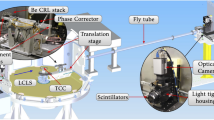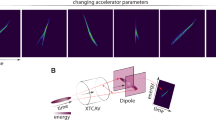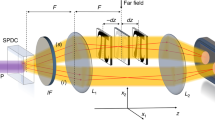Abstract
The advent of accelerator-driven free-electron lasers (FEL) has opened new avenues for high-resolution structure determination via diffraction methods that go far beyond conventional X-ray crystallography methods1,2,3,4,5,6,7,8,9,10. These techniques rely on coherent scattering processes that require the maintenance of first-order coherence of the radiation field throughout the imaging procedure. Here we show that higher-order degrees of coherence, displayed in the intensity correlations of incoherently scattered X-rays from an FEL, can be used to image two-dimensional objects with a spatial resolution close to or even below the Abbe limit. This constitutes a new approach towards structure determination based on incoherent processes11,12, including fluorescence emission or wavefront distortions, generally considered detrimental for imaging applications. Our method is an extension of the landmark intensity correlation measurements of Hanbury Brown and Twiss13 to higher than second order, paving the way towards determination of structure and dynamics of matter in regimes where coherent imaging methods have intrinsic limitations14.
This is a preview of subscription content, access via your institution
Access options
Access Nature and 54 other Nature Portfolio journals
Get Nature+, our best-value online-access subscription
$32.99 / 30 days
cancel any time
Subscribe to this journal
Receive 12 print issues and online access
$259.00 per year
only $21.58 per issue
Buy this article
- Purchase on SpringerLink
- Instant access to full article PDF
Prices may be subject to local taxes which are calculated during checkout



Similar content being viewed by others
References
Chapman, H. N. et al. Femtosecond diffractive imaging with a soft-X-ray free-electron laser. Nat. Phys. 2, 839–843 (2006).
Chapman, H. N. et al. Femtosecond X-ray protein nanocrystallography. Nature 470, 73–77 (2011).
Seibert, M. et al. Single mimivirus particles intercepted and imaged with an X-ray laser. Nature 470, 78–81 (2011).
Loh, N. D. et al. Fractal morphology, imaging and mass spectrometry of single aerosol particles in flight. Nature 486, 513–517 (2012).
Kupitz, C. et al. Serial time-resolved crystallography of photosystem II using a femtosecond X-ray laser. Nature 513, 261–265 (2014).
Takahashi, Y. et al. Coherent diffraction imaging analysis of shape-controlled nanoparticles with focused hard X-ray free-electron laser pulses. Nano Lett. 13, 6028–6032 (2013).
Barke, I. et al. The 3D-architecture of individual free silver nanoparticles captured by X-ray scattering. Nat. Commun. 6, 6187 (2015).
Neutze, R., Wouts, R., van der Spoel, D., Weckert, E. & Hajdu, H. Potential for biomolecular imaging with femtosecond X-ray pulses. Nature 406, 752–757 (2000).
Aquila, A. et al. The linac coherent light source single particle imaging road map. Struct. Dyn. 2, 041701 (2015).
Barty, A., Küpper, J. & Chapman, H. N. Molecular imaging using X-ray free-electron lasers. Annu. Rev. Phys. Chem. 64, 415–435 (2013).
Slovik, J. M., Son, S.-K., Dixit, G., Jurek, Z. & Santra, R. Incoherent X-ray scattering in single molecule imaging. New J. Phys. 16, 073042 (2014).
Gorobtsov, O. Y., Lorenz, U., Kabachnik, N. M. & Vartanyants, I. A. Theoretical study of electronic damage in single-particle imaging experiments at X-ray free-electron lasers for pulse durations from 0.1 to 10 fs. Phys. Rev. E 91, 062712 (2015).
Hanbury Brown, R. & Twiss, R. Q. A test of a new type of stellar interferometer on Sirius. Nature 178, 1046–1048 (1956).
Chapman, H. N. & Nugent, K. A. Coherent lensless X-ray imaging. Nat. Photon. 4, 833–839 (2010).
Hanbury Brown, R. & Twiss, R. Q. Correlation between photons in two coherent beams of light. Nature 177, 27–29 (1956).
Glauber, R. J. Nobel lecture: one hundred years of light quanta. Rev. Mod. Phys. 78, 1267–1278 (2006).
Glauber, R. J. The quantum theory of optical coherence. Phys. Rev. 130, 2529–2539 (1963).
Goodman, J. W. Statistical Optics (John Wiley & Sons, 1985).
Baym, G. The physics of Hanbury Brown-Twiss intensity interferometry: from stars to nuclear collisions. Acta Phys. Pol. B 29, 1839–1884 (1998).
Singer, A. et al. Hanbury Brown-Twiss interferometry at a free-electron laser. Phys. Rev. Lett. 111, 034802 (2013).
Gorobtsov, O. Y. et al. Statistical properties of a free-electron laser revealed by Hanbury Brown-Twiss interferometry. Phys. Rev. A 95, 023843 (2017).
Thiel, C. et al. Quantum imaging with incoherent photons. Phys. Rev. Lett. 99, 133603 (2007).
Oppel, S., Büttner, T., Kok, P. & von Zanthier, J. Superresolving multiphoton interferences with independent light sources. Phys. Rev. Lett. 109, 233603 (2012).
Classen, A. et al. Superresolving imaging of irregular arrays of thermal light sources using multiphoton interferences. Phys. Rev. Lett. 117, 253601 (2016).
Ackermann, W. et al. Operation of a free-electron laser from the extreme ultraviolet to the water window. Nat. Photon. 1, 336–342 (2007).
Goodman, J. W. Speckle Phenomena in Optics: Theory and Applications (Roberts and Company, 2007).
Ayyer, K. et al. Macromolecular diffractive imaging using imperfect crystals. Nature 530, 202–206 (2016).
Acknowledgements
R.S., T.M., A.C., D.B. and J.v.Z. gratefully acknowledge funding by the Erlangen Graduate School in Advanced Optical Technologies (SAOT) by the German Research Foundation (DFG) in the framework of the German excellence initiative. A.C. and D.B. gratefully acknowledge financial support by the Staedtler Foundation and the Cusanuswerk, Bischöfliche Studienförderung, respectively. We acknowledge support of the Helmholtz Association through project oriented funds. I.V. acknowledges the support of the Virtual Institute VH-VI-403 of the Helmholtz Association. Y.O. and S.W. acknowledge support by the Partnership for Innovation, Education and Research (PIER) between DESY and the University of Hamburg. We are grateful to the FLASH machine operators, to the technical staff at FLASH for excellent FEL conditions, and to Holger Meyer for his contributions to the design of the experimental set-up. We appreciate fruitful discussions with E. Weckert and H. N. Chapman.
Author information
Authors and Affiliations
Contributions
J.v.Z., R.R. and I.A.V. conceived the experiment and coordinated the experimental efforts. R.S. and T.M. designed the experimental layout and provided post-measurement analysis and evaluation of experimental data. G.M. designed and built the experimental set-up. G.M., L.W., R.S., T.M., O.G., S.L., P.S. and I.Z. carried out the experiment at FLASH/DESY. A.C. and F.W. developed the idea of sequential spatial frequency filtering in 1D and 2D using higher-order intensity correlations. A.C. and D.B. developed quantum path analysis of the method and mathematical explanation for sub-Abbe resolution. A.B. installed the motor control of the diffusor stage. L.B. coordinated efforts to characterize diffusors and samples. B.F. provided silica particles for production of diffusors. K.S. prepared diffusors and thin film coatings. J.W. prepared the hole mask of the artificial benzene molecule used as sample. S.W. participated in preparation and characterization of diffusors. G.B. provided the operation of the beamline PG2 at FLASH. Y.O. participated in discussion of the theoretical basis of quantum imaging. W.W. provided the end station for measurements at the PG2 beamline. R.S., T.M., J.v.Z., R.R. and I.A.V. wrote the manuscript with contributions and improvements from all authors.
Corresponding author
Ethics declarations
Competing interests
The authors declare no competing financial interests.
Supplementary information
Supplementary information
Supplementary information (PDF 309 kb)
Rights and permissions
About this article
Cite this article
Schneider, R., Mehringer, T., Mercurio, G. et al. Quantum imaging with incoherently scattered light from a free-electron laser. Nature Phys 14, 126–129 (2018). https://doi.org/10.1038/nphys4301
Received:
Accepted:
Published:
Issue date:
DOI: https://doi.org/10.1038/nphys4301
This article is cited by
-
Advancing X-ray quantum imaging through Monte-Carlo simulations
Scientific Reports (2025)
-
Multi-wavelength ghost imaging: a review
Vicinagearth (2025)
-
Terawatt-attosecond hard X-ray free-electron laser at high repetition rate
Nature Photonics (2024)
-
Accessing the quantum spatial and temporal scales with XFELs
Nature Reviews Physics (2020)
-
Diffraction based Hanbury Brown and Twiss interferometry at a hard x-ray free-electron laser
Scientific Reports (2018)



